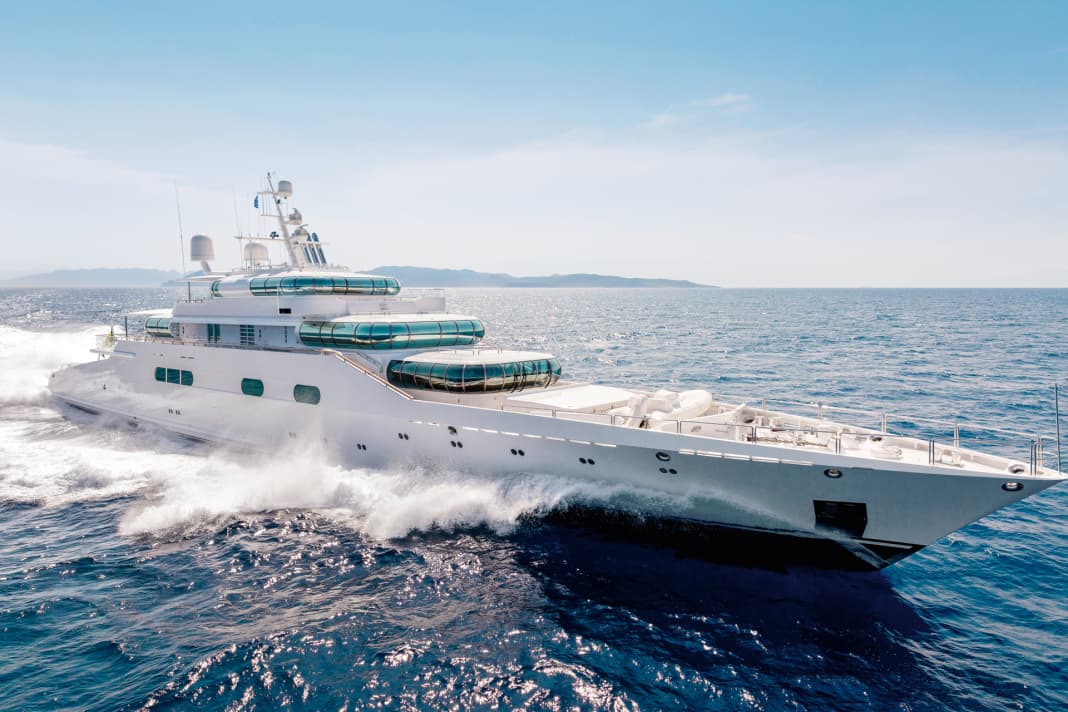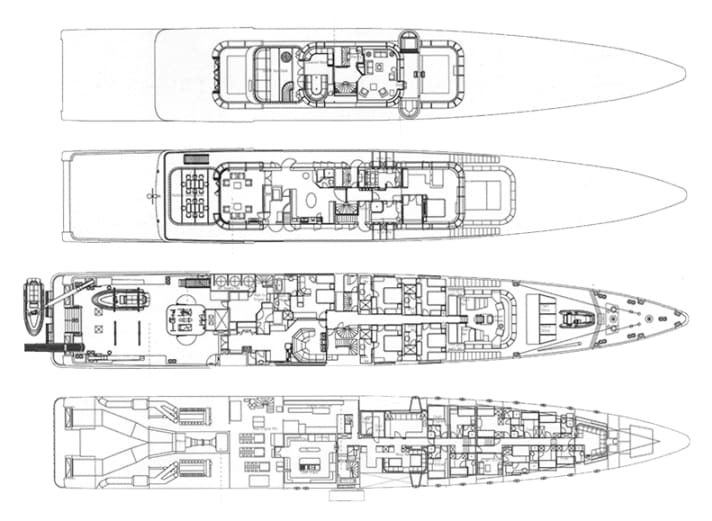





The harbour is full, but she steals the show. Perhaps because she is not built as high as the other modern formats and thus demonstrates the real wealth of her owner? Perhaps because her windows are so unusually shaped that they are more reminiscent of a spaceship than a yacht? Or perhaps because, even more than a quarter of a century after her delivery, there is something mysterious about her? Journalists on board? "No access", they were told until now. "Enigma", the former "Eco" or "Katana", remained private. Marvelling from the outside: yes. Looking through the windows from the inside: no. "Yacht building, radical" was the title of BOOTE EXCLUSIV in 1991, when the Martin-Francis design "Eco" left its dock at Blohm+Voss and was lying in wait - not far from the editorial office - in Hamburg harbour. Details of the hull and propulsion system were revealed and published via coastal gossip. Then radio silence descended over the yacht with the construction number 956.
Until one day, in the late autumn of 2016, the mobile phone rang. It's Martin Francis: "If you're still interested in a visit, meet me on the foredeck at 3 pm." Francis, one of the greats of yacht design and a mentor to highly successful colleagues such as Espen Øino, Dan Lenard and Jonny Horsfield, seems almost a little emotional. "I have spent years of my life designing and redesigning this yacht. The fact that we can now finally show this result to the general public is simply wonderful." The sun is beating down from the sky, but we remain standing outside; the extremely curved windows act like a magnet. Anyone standing in front of them for the first time simply has to touch them. They are 19 millimetres thick, shiny and protect the inside from any external influences.
Inspiration from Parisian buses
Francis took his inspiration from Parisian buses. He presented them to Emilio Azcárraga, the client of "Eco", in a design pitch in which Jon Bannenberg and the famous industrial and automotive designer Giorgio Giugiaro also took part. The Mexican billionaire, who made his fortune with hotels, TV stations and an airline, among other things, opted for Francis' proposal, even though he was already sailing two Bannenberg designs - the 46-metre "Azteca" and "Paraiso"-Feadships - in parallel. "My design," says Francis, "was the most radical. Maybe that's why I was awarded the contract."
Blohm+Voss was chosen as the shipyard, and Francis engaged the German automotive supplier Flachglas as the supplier for the glass. "It was a blue-sky development. No one had ever realised panes like this before," Francis recalls. Would the hull and superstructure also remain rigid enough to prevent the windows from breaking? The semi-circular look ultimately extends over three decks, with the bridge and all electronics located on the main deck, which is the most sensitive. The owner's cabin is enthroned above this, and the lounge on the sundeck is located above that. One of the requirements of the Lloyd's classification society was therefore to carry frame reinforcements, in particular to stabilise the wheelhouse windows in bad weather. "The crew still carry them," says Francis, "but they are never used." Instead, the captain increases the speed in rough seas and overcoming water so that the hull cuts through the waves like a wave piercer. "After all, we have enough capacity in the engine room."
Motorisation of the "Enigma"
The data is indeed impressive. With two 3680 kilowatt Deutz MWM diesels each, which work on two Kamewa waterjets, the 74.50 metre long and only 11.20 metre wide "Enigma" achieves a cruising speed of 18 knots and a range of 2200 nautical miles. However, if a little more speed is required, the captain switches on the General Electric gas turbine, which to date has only been used in such dimensions in naval shipbuilding. An additional 13,800 (!) kilowatts then accelerate the construction made of high-strength special steel and a GRP superstructure weighing just 28 tonnes to up to 35 knots. However, the CODAG (Combined Diesel and Gas) configuration has not been used all that often over the past 25 years. While the two - recently overhauled - main engines have around 22,000 operating hours, the gas turbine has just under 3,000 hours.
After all, "Enigma" is not exactly frugal at over 30 knots: the bunkers with a capacity of 240,000 litres then lose around 5500 litres of diesel per hour. The yacht could travel for 43 hours at this speed, with a range of 1200 nautical miles including the reserve.
"Once," recalls Martin Francis, "we were moored off Palma with the yacht, it had just been delivered. Suddenly the owner said that he would like to be in Porto Cervo in the evening. That was the ultimate test drive." While the captain steered the yacht through the considerable swell, they had a long Mexican lunch. "Afterwards, we watched films, dined and docked around midnight. In the Strait of Bonifacio, the coastguard radioed us. They had never seen a speed object of this size on their radar before."
Interior of the motor yacht
We are now slowly moving towards the interior, which was first designed by Francis and François Zuretti. "Not much has changed," says Francis, surprisingly. At first glance, the interior looks modern and friendly and in no way out of date. If you look at the refit documentation, it mainly lists the replacement of technical components and new leather upholstery for the interior. Due to the flat silhouette and narrow width of the yacht, the rooms are somewhat cosier than on conventional 70-metre formats; however, the view from the flat glass windows is spectacular and gives any room that has them an extra kick. We first enjoy it on the bridge, which is installed ahead of the four guest cabins in the bow of the main deck. What was considered a completely impossible placement of a wheelhouse when "Eco" was delivered has proven itself over 25 years. "What's more," adds Martin Francis, "we had no choice. Emilio Azcárraga wanted his cabin one deck higher so that he could enjoy a better view up there."
The look of the bridge certainly suits its job; black leather, a teak floor, five screens and illuminated throttles exude a technical and masculine atmosphere. More than half of the lower deck and part of the tank deck are controlled from here - the propulsion system, generators and other components required to operate a yacht like this take up so much space. Incidentally, the 21-strong "Enigma" crew relies on equipment from Raytheon Anschütz, Saab, Furuno and B&G for navigation and communication.
Behind the guest cabins on the main deck is a cinema and, further aft, two interesting features that the second "Enigma" owner, sports enthusiast Larry Ellison, had installed. He renamed "Eco" the "Katana". "Larry needed a gym, which we installed on the aft deck with glass all round," explains Francis. He also had the seaplane that Azcárraga had parked aft removed and a basketball hoop hung on the front of the superstructure. "As soon as the tenders were in the water, we could play," smiles Francis.
Traces of the past
Incidentally, Ellison only bought the yacht after Azcárraga had died. The Mexican loved "Eco" so much that he spent the last months of his life on her.
We are standing in the owner's cabin where he died when Francis tells us this. Previously, his client had sailed "Eco" across the Atlantic six times, travelling from Hamburg via St. Petersburg, the Balearic Islands, the Caribbean and the Panama Canal to Los Angeles in just one season. A tanker purchased in Denmark was on board to supply fuel, so that diesel could be topped up in the middle of the Atlantic.
Azcárraga's decision to set up his cabin above the bridge was spot on. The view through the convex flat glass windows without any distortion is even better than on the bridge. On this deck, between the suite and the saloon, is the dining area, which seats up to ten guests and has been removed from the saloon over the years. There is now a sofa area. A wide-opening sliding door connects the inside with the outside deck, where guests can dine al fresco at two tables under a fixed awning. This is the area that is primarily reserved for guests, as the forward lounge on the top deck can be closed off by the owner, turning his cabin into a maisonette flat.
The most beautiful place on board "Enigma"
As we sit down on the daybeds in the nocks of this deck, it becomes clear why the now third and rather shy "Enigma" owner also sometimes prefers this option. It is perhaps the most beautiful place on board - even before the glazing.
Technical data
- Length over everything:74,50 m
- Width: 11,20 m
- Depth: 3,50 m
- Gross tonnage: 1150 GT
- Material:Steel, GRP
- Motor: 2 x MWM Deutz 16M
- Gas turbine: GE LM 1600
- Waterjets: 3 x KaMeWa
- Engine power: 2 x 3680 kW, 1 x 13 800 kW
- Speed (max.): 35 kn
- Speed (travelling): 18 kn
- Fuel: 239 000 l
- Range:2200 nm @ 18 kn
- Water: 37 000 l
- Generator: 3 x Scania, 260 kW each
- Tender: 2 x Custom, 1 x Novurania
- Construction: Martin Francis
- Styling: Martin Francis
- Interior design: Francis, Zuretti
- Classification: Lloyd's, 100 A1 Yacht, LMC UMS
- Shipyard: Blohm + Voss, 1991
- Broker: Edmiston

This article appeared in BOOTE EXCLUSIV issue 02/2017 and was revised by the editorial team in May 2023.

